State of the Art Research and Development
At Katun, we make it our business to understand the office equipment you service inside and out. In our state-of-the-art research and development facility, Katun engineers and technical specialists are focused on providing you with the world’s best values in office equipment parts and supplies.
Developed and tested in our practical applications laboratory, virtually every Katun product must demonstrate excellent in-machine performance before it is introduced. We maintain over 550 copiers, facsimiles, printers and multifunctional devices to conduct our tests, and our entire testing area is constantly maintained at a “normal” operating environment for office equipment: 70° F (21 C° ) ± 2° , and 50 percent relative humidity (50% RH) ± 5%.
In addition to the new and older-generation machines in which we conduct performance and life testing, trained technical specialists operate high technology instrumentation to analyze critical materials properties and corresponding performance characteristics of both Katun and competitive products. Many of these sensitive instruments are operated in a Class M6.5 Clean Room for measurement integrity and precision.
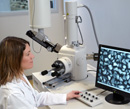 |
A Scanning Electron MicroscopeA Scanning Electron Microscope (SEM) with an energy-dispersive x-ray spectrometer (EDS) enables Katun to perform elemental analyses of both organic and inorganic materials. Practical applications of these capabilities include precise determination of chemical composition of coatings, developer carriers, and various parts. The imaging capabilities of the SEM/EDS permit viewing of material samples at magnifications up to 300,000X, and integrated computer software and hardware allow extensive processing, archiving, and playback of stored digital images. For maximum efficiency and productivity, this system allows simultaneous operator control of image acquisition and x-ray analysis, while providing automatic adjustment of imaging variables such as filament saturation, focus, and contrast. With the SEM/EDS, Katun achieves substantial time savings by performing sophisticated elemental analyses and correlates this data with manufacturers as a quality assurance measure. In addition, the increased understanding of part/product composition and physical interaction contribute directly to Katun’s overall product development capabilities and efficiency. |
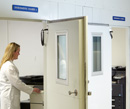 |
Three walk-in Environmental Testing ChambersThree walk-in Environmental Testing Chambers produce and maintain specified temperatures from 10° F to 110° F (-12° C to 43° C) ± 2° , and relative humidity from 15% to 95% RH ± 3%. They are equipped with individual steam generators and are designed to maintain balanced airflow, which facilitates accurate and efficient environmental testing of products. Each chamber can accommodate up to six test machines, allowing the simultaneous testing of multiple Katun toners/developers, photoreceptors, and other products under the wide range of environmental conditions to which they are subjected worldwide. |
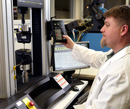 |
A Tensile/Compression TesterA Tensile/Compression Tester enables precise determination of the responses of materials to various forces and load conditions. Such data enable Katun technicians and engineers to efficiently measure peel strength, stretching threshold, tear strength and other material properties essential to the development of various products. |
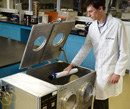 |
A Vacuum ChamberA Vacuum Chamber is useful in evaluating feasibility of new product packaging and toner cartridges for worldwide distribution. This piece of equipment simulates both pressurized and non-pressurized cargo environments. |
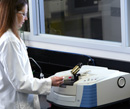 |
A Fourier Transform Infrared Spectrometer (FTIR)A Fourier Transform Infrared Spectrometer (FTIR) provides accurate identification of organic compounds such as toners and rubber-based components. |
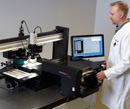 |
The ImageXpertThe ImageXpert is a vision based image quality measurement system, which uses a very powerful software package designed specifically for image analysis. Using a high-resolution scanner with an automatic document feeder, the ImageXpert is capable of performing image analysis on test targets with high accuracy and speed. This scanner-based system is capable of measuring many important copy quality characteristics including:
The subjectivity of test results is greatly reduced by using this system, as not only does it increase the consistency and accuracy of our measurements, it reduces our testing throughput time. |
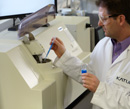 |
The Sysmex FPIA-3000The Sysmex FPIA-3000 (Flow Particle Image Analyzer) enables reliable, repeatable and routine characterization of particle size distributions and particle shape distributions using automated imaging techniques. When a toner sample (dilute suspension of particles) passes though the machine, a CCD camera captures individual particle images. The machine collects material properties data, including the determination of particle size distribution and circularity (which impacts proper coverage and image quality). The Sysmex FPIA-300 also measures toner density, graininess, and even color reproduction capabilities. In addition, when used in analysis of OEM toner, this device provides data on the manufacturing process (chemically-produced vs. conventionally-produced, etc.) used in the production of the toner. |
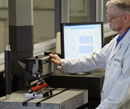 |
Surface AnalyzerComputer-controlled for accuracy and repeatability, the Surface Analyzer performs detailed analyses of surface characteristics of photoreceptors, fuser rollers, feed belts and other parts to sub-micron level resolution. |
A Noncontact Video Measuring SystemA Noncontact Video Measuring System enables the detailed geometric analysis of virtually any part. It automates comparative analyses of parts, creates parts measurement programs that ensure accuracy and repeatability, and creates informative reports and diagrams. |
|
A Computer-Controlled Adaptive Fuser StationA Computer-Controlled Adaptive Fuser Station, equipped with temperature and speed controls, precisely simulates the critical fusing conditions of most office equipment, enabling controlled measurement of toner fusibility, toner non-offset window, and other product performance factors. |
|
The ADVANTESTThe ADVANTEST R8340 is an ultra high resistance meter used to analyze volume and surface resistance of materials used in the manufacture of copier components. Items such as image transfer belts need to closely match original equipment manufacturer specifications and characteristics to perform properly. This ultra high resistance meter provides the exacting data needed in the research and evaluation of these parts. |
|
The PIAS-IIThe PIAS-II (Personal Image Analysis System) provides a broad range of IQ analysis functions, and addresses the requirements of portability, flexibility, upgradeability, affordability, and most importantly, ease-of-use. A high-performance digital microscope (with high-res and low-res lens interchangability) built on international print quality standards for mobile, networkable, objective image quality analysis. The device measures LAB values, resolution, background values, print quality, color purity, etc. |
|